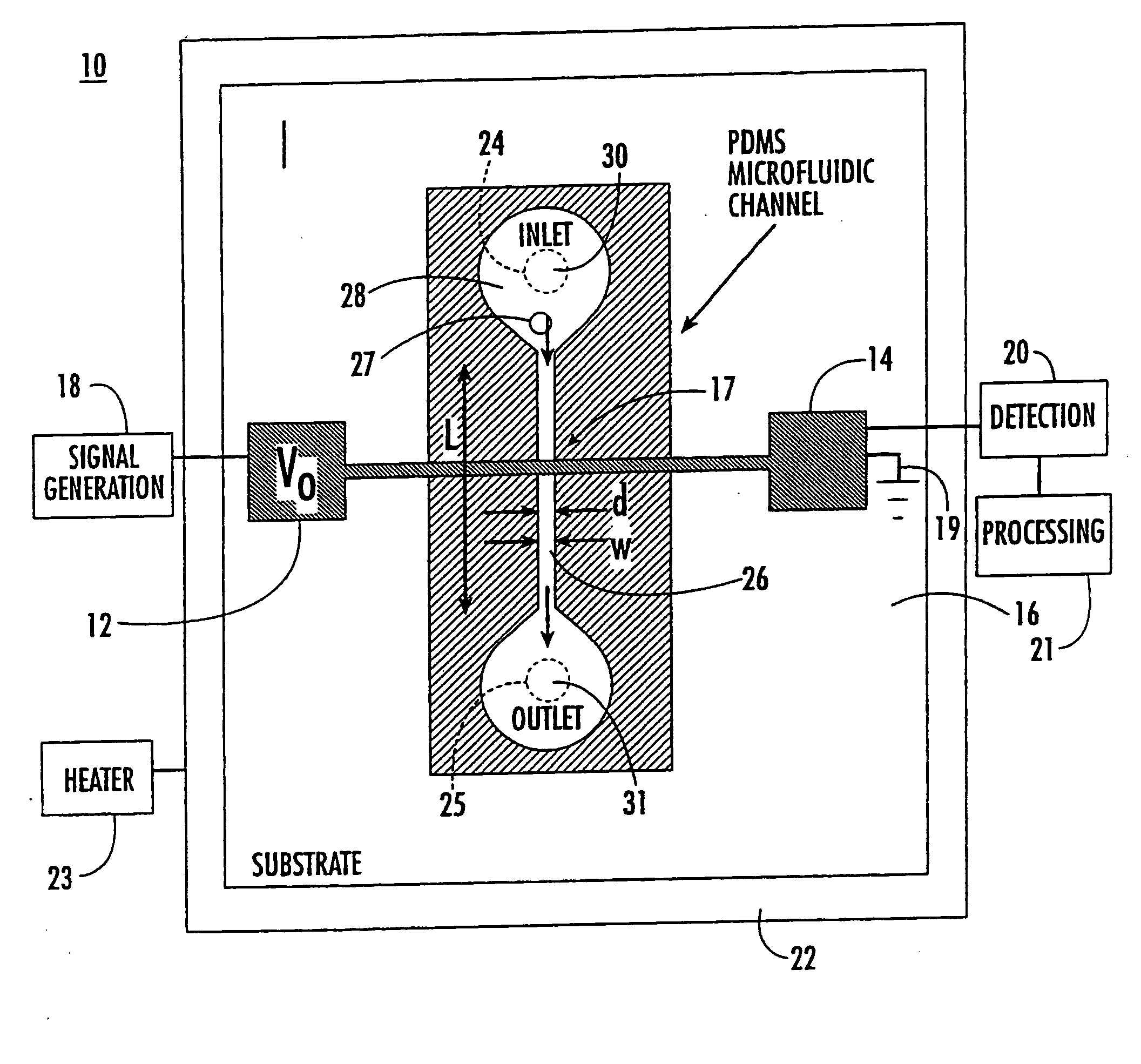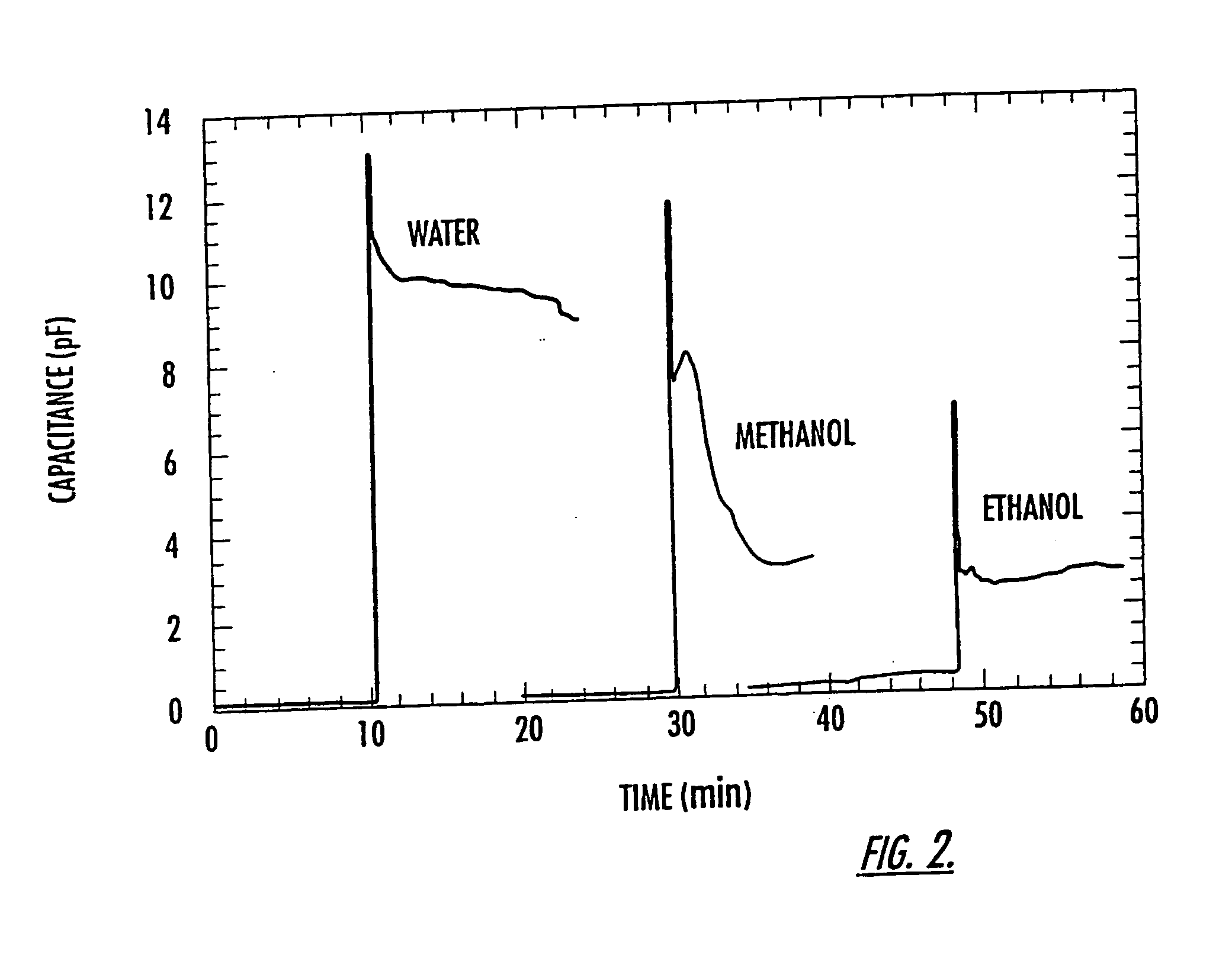Microfluidic and nanofluidic electronic devices for detecting changes in capacitance of fluids and methods of using
a technology of electrical devices and fluids, applied in the field of microfluidic and nanofluidic electrical devices, can solve the problems of limiting the general application of sensors to such probes, laborious sequencing of dna, and difficulty in realizing such probes, and achieves the effects of simple, fast, and less expensiv
- Summary
- Abstract
- Description
- Claims
- Application Information
AI Technical Summary
Benefits of technology
Problems solved by technology
Method used
Image
Examples
example 1
Detecting Capacitance of Fluids
[0096] Microfluidic device 10 of the present invention is capable of detecting the capacitance of different fluids. The microfluidic device used for this experiment is shown in FIG. 1 having d 30 μm and h=30 μm.
[0097] As shown in FIG. 2, there is a dramatic increase in both CT, and R once fluid flows past the electrodes (CTinitials measures 0.10 pF when the electrodes are dry). Although some settling time is needed for the device, the final values of CTinitials are 9, 3 and 2.5 pF for water, methanol, and ethanol, respectively. As expected, the change in capacitance ΔCT, scales with the dielectric constant of the fluid, i.e. (CT(final)−CT(initial)) / CT(initial)=for water is ˜90, that of methanol ˜30, and that of ethanol ˜25. Deviations from the actual dielectric constant of the three different solvents (water=80, methanol=33, and ethanol=24) are a result of stray capacitances, some of which are not affected by the fluid. These results demonstrate that...
example 2
Detecting Different Ionic Concentrations
[0098] Microfliudic device 10 of the present invention was used to detect differences in ionic strength of fluids. The microfluidic device used for this experiment is that shown in FIG. 1.
[0099]FIG. 3 shows the sensitivity of our device to different ionic concentrations. The buffer 2-(N morpholino) ethane-sulfonic acid (MES) was used at varying pH (pH −4.52, 5.07, and 6.18). As shown in the figure, the device is able to distinguish the different fluids and measure differences in ionic concentrations.
example 3
Detection of Single Mouse Myeloma Cells in a Fluid and Correlation Between Capacitance and Cellular DNA Content
[0100] The microfluidic device shown in FIG. 1 was used to detect individual, single cells and determine the content or amount of DNA in the individual cells. Also, the cell cycle stage for individual cells within a population of cells was determined and compared using flow cytometry and capacitance cytometry of the present invention. The cell cycle stage of the individual cells is determined by measuring the cellular DNA content.
[0101] Mouse myeloma cells (SP2 / 0), a malignant cell line, were grown in suspension to a density of approximately 105 cells / mL. The cells were then washed in phosphate-buffered saline (PBS) solution (pH 7.4), fixed in 75% ethanol at −20° C. for a minimum of 24 hours, washed again with PBS solution, treated with RNAase, and then washed and resuspended for storage in 75% ethanol. Standard analysis (FACScan flow cytometer, Becton Dickinson Immunocyt...
PUM
| Property | Measurement | Unit |
|---|---|---|
| distance | aaaaa | aaaaa |
| width | aaaaa | aaaaa |
| height | aaaaa | aaaaa |
Abstract
Description
Claims
Application Information
 Login to View More
Login to View More - R&D
- Intellectual Property
- Life Sciences
- Materials
- Tech Scout
- Unparalleled Data Quality
- Higher Quality Content
- 60% Fewer Hallucinations
Browse by: Latest US Patents, China's latest patents, Technical Efficacy Thesaurus, Application Domain, Technology Topic, Popular Technical Reports.
© 2025 PatSnap. All rights reserved.Legal|Privacy policy|Modern Slavery Act Transparency Statement|Sitemap|About US| Contact US: help@patsnap.com



